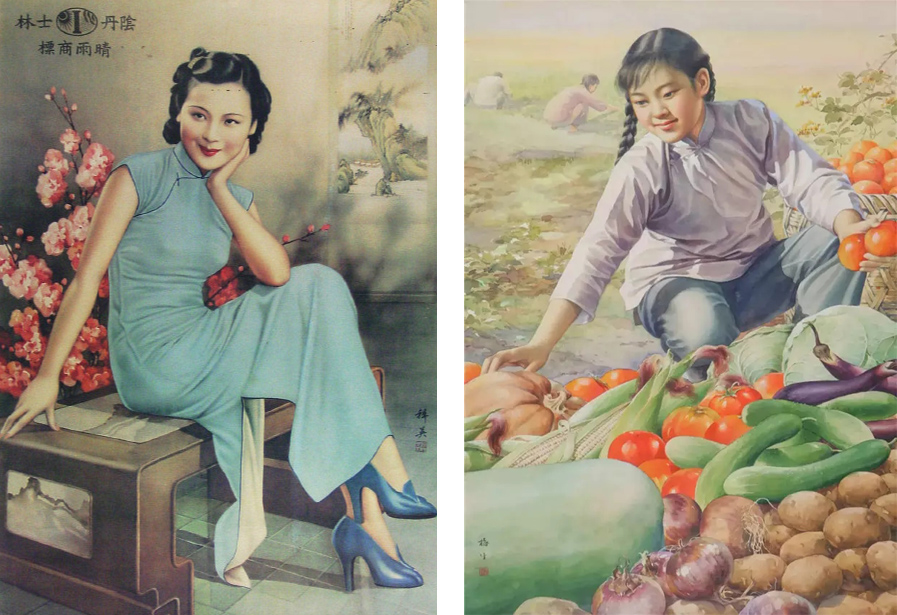The enduring appeal of Yuefenpai

The image (left) is a part of a Republican era advertisement for Indanthren cloth; the other (right) is a part of the famous yuefenpai nianhua, "The Vegetables Are Green, The Cucumbers Plumb, The Yield Is Abundant," painted by Jin Meisheng in 1955. Photo: FILE
The yuefenpai (literally, chart of months) is a type of calendar poster that was prevalent during the Republican period (1912–1949). As an advertisement in the form of a calendar, the yuefenpai were given with sold items to customers as free gifts, or handed out to passers-by. These posters, after being taken home, were usually pinned up on the walls as decoration and calendars. At that time, the yuefenpai were adored not only by the people of Shanghai but also by other domestic markets and the overseas Chinese in Southeast Asian countries.
The images on the early yuefenpai were mostly based on historical or legendary characters derived from traditional Chinese culture, and the painting techniques were fine brush techniques (gongbi). However, these images of a traditional style seemed not to match the products they were supposed to advertise and were considered to lack a sense of fashion. Soon the images on the yuefenpai were shifted to portraits of modern ladies, painted with a special painting technique known as rub-and-paint. Yuefenpai began to influence people’s tastes and lifestyle.
The yuefenpai that featured beautiful young ladies not only dominated commercial advertising during the Republican period but also epitomized the rapidly modernizing China of the time. The portraiture that was published on yuefenpai tended to feature women with alluring eyes, a closed-lips smile, smooth skin and slim body, as signs of classical beauty.
At that time, commercial advertising that featured on the yuefenpai reflected the competition between home-made products and foreign products. Competition in advertising started from the marketing of foreign goods. Soon domestic producers followed suit and hired artists to design the yuefenpai for their products. This competition of commodities became a competition of artists. The advertising in Shanghai, which was represented by the yuefenpai, reached its peak around the 1930s. There were at least a few scores of recorded advertising companies listed in Shanghai at the time. The yuefenpai was first used as an advertisement for highly profitable commodities such as cigarettes and medicine. For example, the British American Tobacco Corporation (BAT) established its advertising department and painting studio in 1902, both of which were soon copied by Chinese peers. The BAT was known for its competitive advertising crew. In addition to professional artists from Britain, America, Germany and Japan, the BAT also recruited dozens of Chinese artists, including Hu Boxiang, Ding Song, Zhang Guangyu and Tang Jiuru. These artists were effective in different aspects of painting. Hu Boxiang was good at painting landscapes using the techniques of traditional Chinese painting and watercolor painting; black-and-white portraiture was Ding Song’s forte; Zhang Guangyu was known for his creativity on the decorative borders and patterns of yuefenpai. Both foreign and Chinese artists had to take the appetite of the consumers into consideration. Therefore, the elements and themes of traditional Chinese culture were essential to the design of yuefenpai.
The images on yuefenpai mirrored the fashion and the taste of the time. Lured by the powerful signals that emanated from the poster beauties, smoking even became the norm for upper-class women in Republican Shanghai. Yuefenpai also provided a glimpse into the social lives of the time. Many portraitures liberated women from domestic confinement by depicting them playing outdoor sports, such as riding motorbikes, swimming, riding horses and boating. This indicated the social changes of the time and the rise of Chinese women’s social status. Yuefenpai epitomized the culture of an era, featuring the cultural integration and innovation that was growing between China and the West.
This article was edited and translated from Guangming Daily. Chen Hongyu is an associate research fellow from Beijing Academy of Social Sciences.
edited by REN GUANHONG
